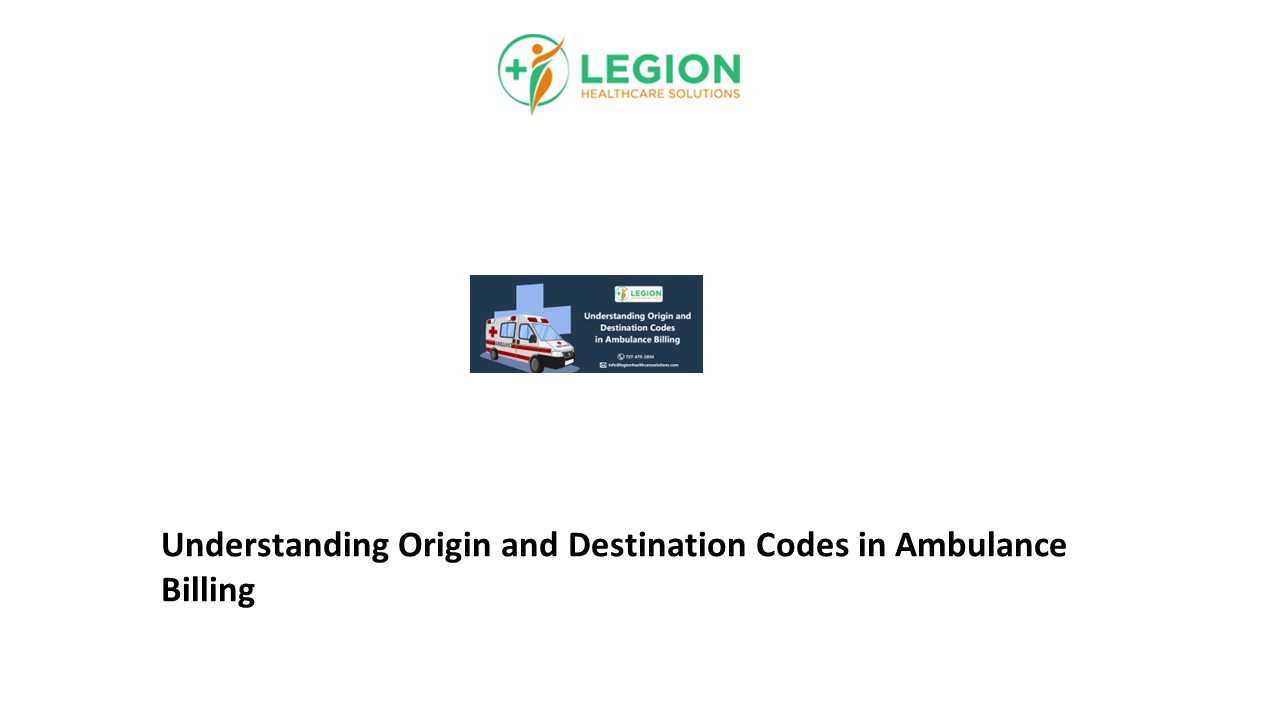Understanding Origin and Destination Codes in Ambulance Billing - PowerPoint PPT Presentation
Title:
Understanding Origin and Destination Codes in Ambulance Billing
Description:
An important ambulance billing best practice is knowing how to code ambulance transport origins and destinations properly. When it comes to identifying proper origin and destination codes in medical billing, it is a common practice to follow the Centers for Medicare and Medicaid (CMS) guidelines for ambulance billing, given most commercial carriers have adopted these guidelines as well. That’s why we referred CMS document to explain origin and destination codes in ambulance billing. – PowerPoint PPT presentation
Number of Views:1
Title: Understanding Origin and Destination Codes in Ambulance Billing
1
Understanding Origin and Destination Codes in
Ambulance Billing
2
Understanding Origin and Destination Codes in
Ambulance Billing
- An important ambulance billing best practice is
knowing how to code ambulance transport origins
and destinations properly. When it comes to
identifying proper origin and destination codes
in medical billing, it is a common practice to
follow the Centers for Medicare and Medicaid
(CMS) guidelines for ambulance billing, given
most commercial carriers have adopted these
guidelines as well. Thats why we referred CMS
document to explain origin and destination codes
in ambulance billing. - Origin and Destination Codes in Ambulance Billing
- For ambulance service claims, institutional-based
providers and suppliers must report origin and
destination codes for each ambulance trip. Origin
and destination codes used for ambulance services
are created by combining two alpha characters.
Each alpha character, with the exception of X,
represents an origin code or a destination code.
The pair of alpha codes creates one code to be
reported in modifier field. The first position
alpha code equals origin the second position
alpha code equals destination. The Centers for
Medicare Medicaid Services (CMS) maintains the
list of valid codes. Origin and destination codes
and their descriptions are as follows - D Diagnostic or therapeutic site other than P
or H when these are used as origin codes - E Residential, domiciliary, custodial facility
(other than 1819 facility) - G Hospital based ESRD facility
- H Hospital
- I Site of transfer (e.g. airport or helicopter
pad) between modes of ambulance transport
3
Understanding Origin and Destination Codes in
Ambulance Billing
- J Freestanding ESRD facility
- N Skilled nursing facility
- P Physicians office
- R Residence
- S Scene of accident or acute event
- X Intermediate stop at physicians office on
way to hospital (destination code only) - While combinations of these items may duplicate
other HCPCS modifiers, when billed with an
ambulance transportation code, the reported
modifiers can only indicate origin/destination.
Beginning with start date of the ET3 Model on
January 1, 2021 (and only for as long as the CMS
ET3 Model is in effect), CMS is allowing the
following alpha character modifiers to be used in
the destination position of the
origin/destination modifier combination on
Emergency Triage, Treat, and Transport (ET3)
Model ambulance claims to indicate, an allowable
alternative destination or in the case of the
beneficiary being treated in place (no transport
of the beneficiary occurs) - C Community Mental Health Center
- F Federally Qualified Health Center
- Physicians Office
- U Urgent Care Facility
- W Treatment in Place (in person or via
telehealth)
4
Understanding Origin and Destination Codes in
Ambulance Billing
- Note that these new destination codes are to be
used on ET3 Model ambulance claims only and shall
not be used, in any circumstance, in the origin
code position of an ambulance service line HCPCS
origin/destination modifier combination. These
codes are only to be used by selected ET3 Model
Participants. - Emergency Triage, Treat, and Transport (ET3)
Model - Emergency Triage, Treat, and Transport (ET3) is a
voluntary, five-year payment model that will
provide greater flexibility to ambulance care
teams to address emergency health care needs of
Medicare Fee-for-Service (FFS) beneficiaries
following a 911 call. CMS will continue to pay to
transport a Medicare FFS beneficiary to a
hospital emergency department or other covered
destination. In addition, under the model, CMS
will pay participants to - transport to an alternative destination partner,
such as a primary care office, urgent care
clinic, or a community mental health center
(CMHC), or - initiate and facilitate treatment in place with a
qualified health care partner, either at the
scene of the 911 emergency response or via
telehealth. - The model will allow beneficiaries to access the
most appropriate emergency services at the right
time and place. As a result, the ET3 Model aims
to improve quality and lower costs by reducing
avoidable transports to the ED and unnecessary
hospitalizations following those transports.
5
Understanding Origin and Destination Codes in
Ambulance Billing
Legion Healthcare Solutions is a leading medical
billing company providing complete billing and
coding services. We can help you in receiving
timely and accurate reimbursements for ambulance
services. To know more our billing and coding
services, contact us at 727-475-1834 or email us
at info_at_legionhealthcaresolutions.com
6
(No Transcript)































